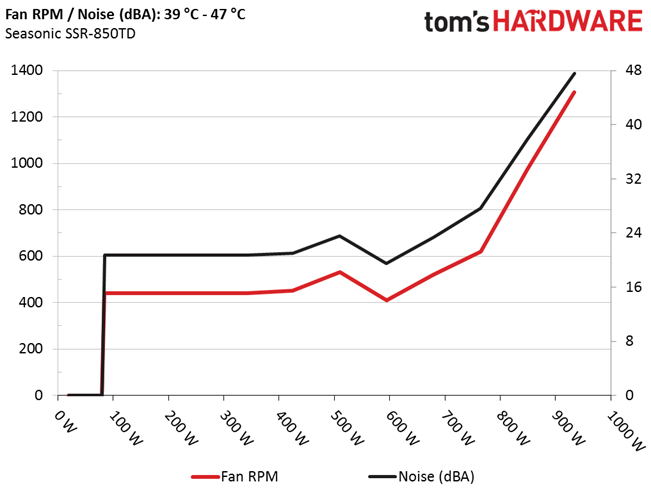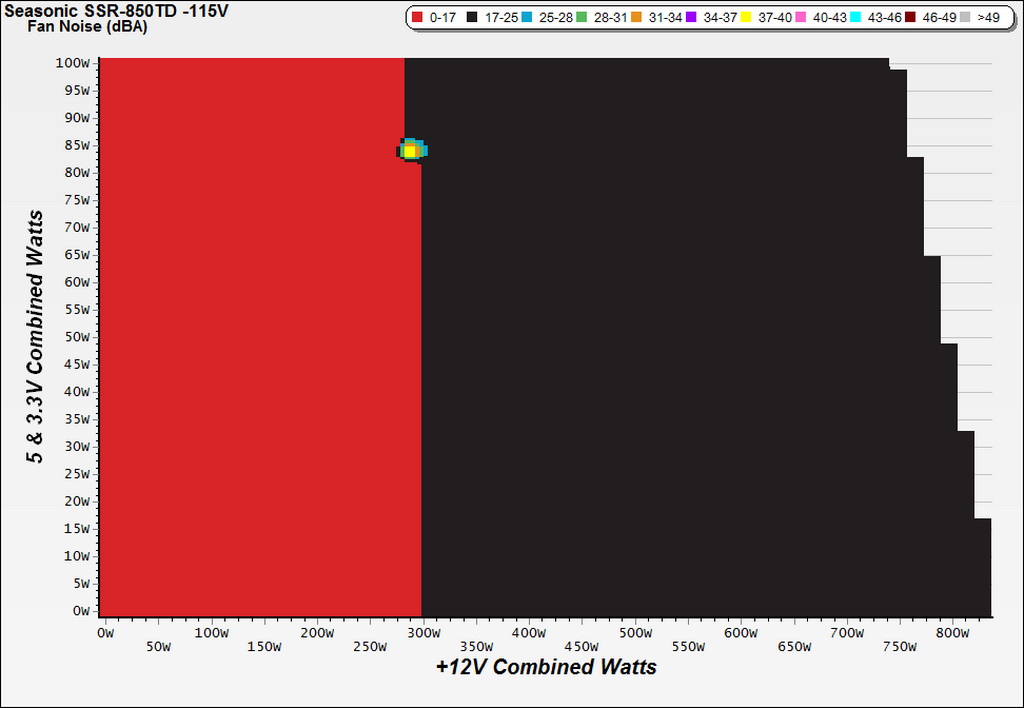Seasonic Prime 850 W Titanium PSU Review
Seasonic made an impressive entry in the 80 PLUS Titanium category with its Prime series. This line's current flagship, offering 850W capacity, is being reviewed today. Besides high efficiency, it sports quiet operation and top performance.
Why you can trust Tom's Hardware
Efficiency, Temperature, And Noise
Efficiency
Our efficiency testing procedure is detailed here.
Using results from the previous page, we plotted a chart showing the SSR-850TD's efficiency at low loads, and loads from 10 to 110 percent of its maximum-rated capacity.
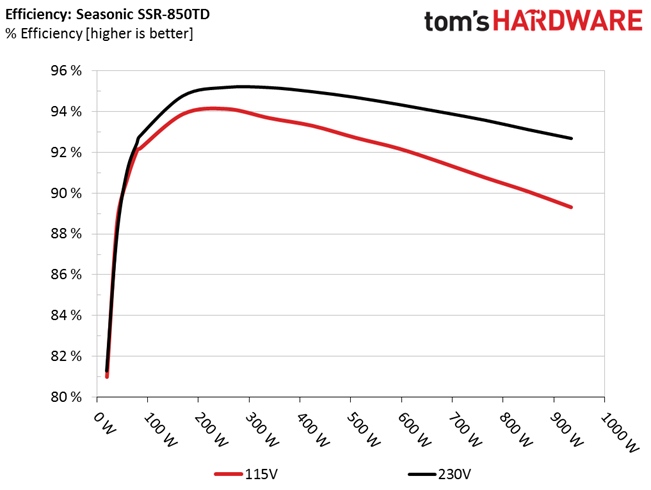
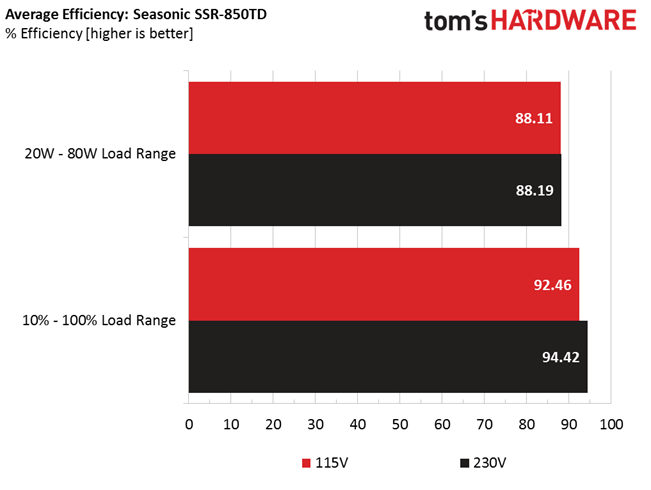
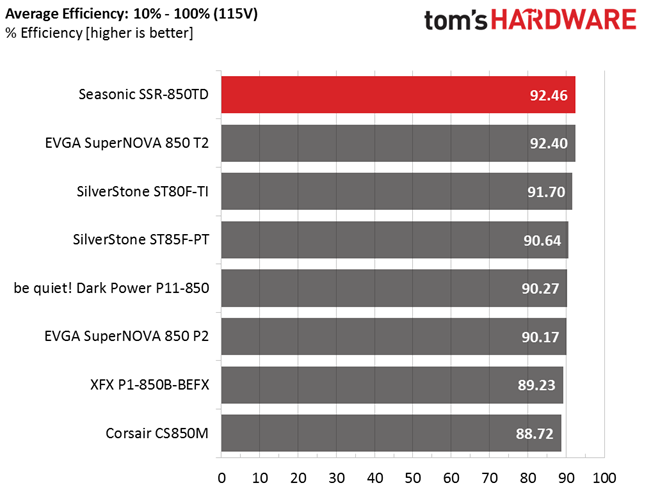
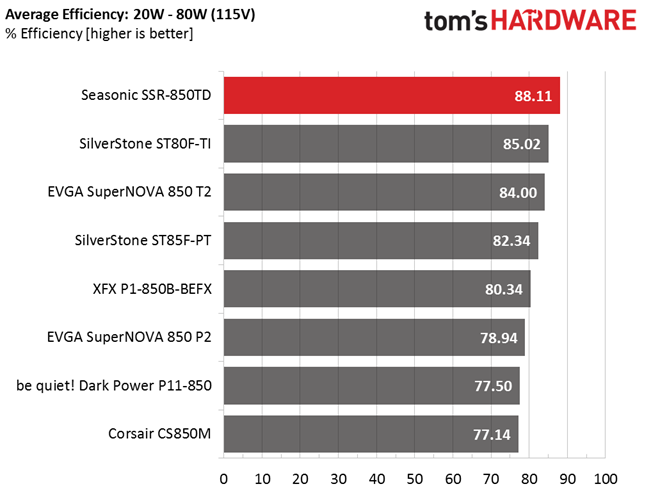
When we measure light and normal loads, the Prime 850 W easily takes the lead from its direct opponent, EVGA's 850 T2, based on Super Flower's Titanium Leadex platform. However, our cross-load tests, where we measure the average efficiency for over 25,000 possible load combinations with the +12V, 5V, and 3.3V rails, reveal that the 850 T2 has a small advantage. This still doesn't change the fact that the Prime 850 W is one of the most efficient PSUs we've ever tested.
Efficiency At Low Loads
In the following tests, we measure the SSR-850TD's efficiency at loads significantly lower than 10 percent of its maximum capacity (the lowest load the 80 PLUS standard measures). The loads we dialed were 20, 40, 60, and 80W. This is important for representing when a PC is idle, with power-saving features turned on.
| Test # | 12V | 5V | 3.3V | 5VSB | DC/AC (Watts) | Efficiency | Fan Speed | Fan Noise | PF/AC Volts |
|---|---|---|---|---|---|---|---|---|---|
| 1 | 1.200A | 0.492A | 0.477A | 0.195A | 19.61 | 81.00% | 0 RPM | 0 dB(A) | 0.799 |
| 12.131V | 5.039V | 3.341V | 5.031V | 24.21 | 115.1V | ||||
| 2 | 2.429A | 0.990A | 0.986A | 0.396A | 39.74 | 88.59% | 0 RPM | 0 dB(A) | 0.912 |
| 12.131V | 5.038V | 3.340V | 5.024V | 44.86 | 115.1V | ||||
| 3 | 3.662A | 1.476A | 1.493A | 5.019A | 59.83 | 90.72% | 0 RPM | 0 dB(A) | 0.952 |
| 12.131V | 5.039V | 3.341V | 5.019V | 65.95 | 115.1V | ||||
| 4 | 4.880A | 1.985A | 1.974A | 0.797A | 79.79 | 92.14% | 0 RPM | 0 dB(A) | 0.966 |
| 12.130V | 5.040V | 3.341V | 5.012V | 86.60 | 115.1V |
Efficiency under light loads is impressive! Even with less than 20W load this PSU passes the 80% mark.
5VSB Efficiency
The ATX specification states that 5VSB standby supply efficiency should be as high as possible, recommending 50 percent or higher efficiency with 100mA of load, 60 percent or higher with 250mA of load, and 70 percent or higher with 1A or more of load.
We take four measurements: one each at 100, 250 and 1000mA, and one with the full load the 5VSB rail can handle.
Get Tom's Hardware's best news and in-depth reviews, straight to your inbox.
| Test # | 5VSB | DC/AC (Watts) | Efficiency | PF/AC Volts |
|---|---|---|---|---|
| 1 | 0.101A | 0.51 | 73.91% | 0.075 |
| 5.008V | 0.69 | 115.1V | ||
| 2 | 0.251A | 1.26 | 78.75% | 0.160 |
| 5.000V | 1.60 | 115.1V | ||
| 3 | 1.002A | 4.97 | 80.55% | 0.351 |
| 4.958V | 6.17 | 115.1V | ||
| 4 | 3.001A | 14.56 | 78.87% | 0.462 |
| 4.851V | 18.46 | 115.1V |
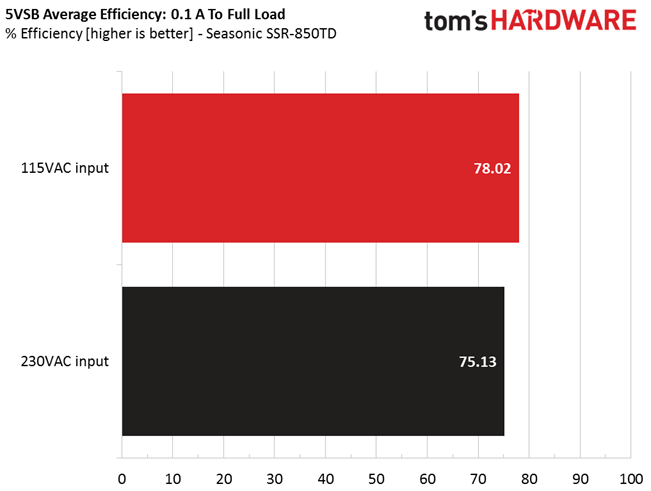
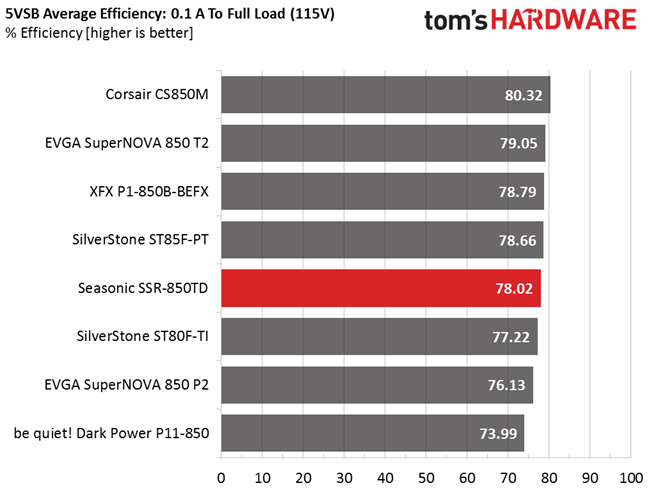
The 5VSB rail performs well, though it doesn't set new records in this category. Seasonic should probably make some changes in this circuit to get it on the same level as the other rails.
Power Consumption In Idle And Standby
In the table below, you'll find the power consumption and voltage values of all rails (except -12V) when the PSU is idle (powered on, but without any load on its rails), and the power consumption when the PSU is in standby mode (without any load, at 5VSB).
| Mode | 12V | 5V | 3.3V | 5VSB | Watts | PF/AC Volts |
|---|---|---|---|---|---|---|
| Idle | 12.133V | 5.042V | 3.341V | 5.042V | 6.75 | 0.422 |
| 115.1V | ||||||
| Standby | 0.06 | 0.007 | ||||
| 115.1V |
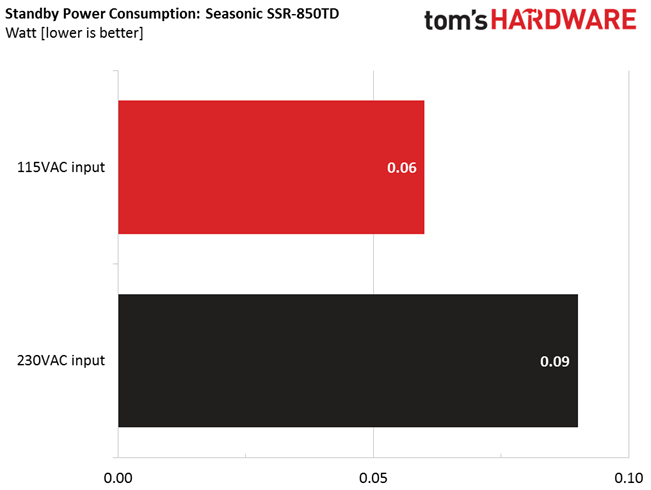
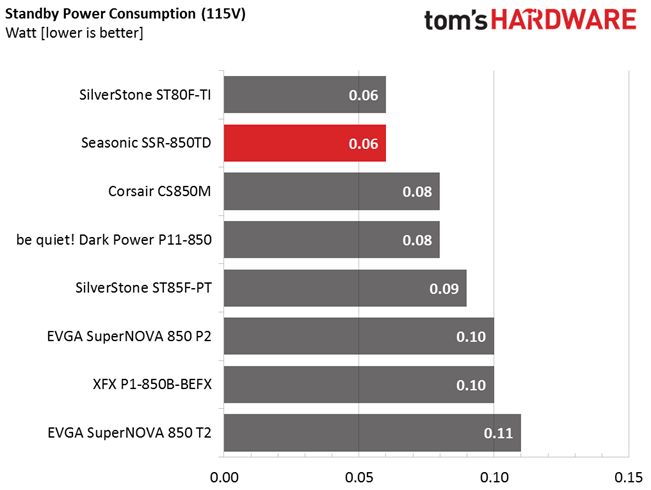
Vampire power is incredibly low, especially with 230V input.
Fan RPM, Delta Temperature, And Output Noise
Our mixed noise testing is described in detail here.
The first chart below illustrates the cooling fan's speed (in RPM), and the delta between input and output temperature. The results were obtained at 39°C (102.2°F) to 47°C (116.6°F) ambient temperature.
The next chart shows the cooling fan's speed (again, in RPM) and output noise. We measured acoustics from one meter away, inside a small, custom-made anechoic chamber with internals completely covered in sound-proofing material (be quiet! Noise Absorber kit). Background noise inside the chamber was below 18 dB(A) during testing, and the results were obtained with the PSU operating at 39°C (102.2°F) to 47°C (116.6°F) ambient temperature.
The following graph illustrates the fan's output noise over the PSU's operating range. The same conditions of the above graph apply to our measurements, though the ambient temperature was between at 28°C (82.4°F) to 30°C (86°F).
The passive mode at normal operating temperatures lasts up until we apply 300W of load. Afterwards, the fan spins fast for several seconds before dropping its speed to a very low level where the output noise is insignificant.
Current page: Efficiency, Temperature, And Noise
Prev Page Load Regulation, Hold-Up Time, And Inrush Current Next Page Protection Features
Aris Mpitziopoulos is a contributing editor at Tom's Hardware, covering PSUs.
-
Nintendork There's no need for CF/SLI anymore, the typical PC + RX480/1080 class gpu barely goes above 300w (even less with APU setups or RX460/1050ti). We need way more 400-500w Titanium PSU's.Reply
We should have 90% efficiency at 50w load with PSU's in that wattage range. -
WFang I'm eagerly anticipating the 600W Passive Seasonic Titanium unit.. I read about it almost a year ago, and still have not seen it tested here ... hope that changes soon.Reply -
Unolocogringo Reply18846027 said:There's no need for CF/SLI anymore, the typical PC + RX480/1080 class gpu barely goes above 300w (even less with APU setups or RX460/1050ti). We need way more 400-500w Titanium PSU's.
We should have 90% efficiency at 50w load with PSU's in that wattage range.
Just because you do not need one , does not mean others don't.
I run multiple graphics cards for Folding@Home.The more you can run on each CPU the better. People who run Dual 1080s or dual 39x cards need them to push their 4K monitors.
So there is a need for them.
-
TJ Hooker Reply
The thing is, efficiency arguably matters less the lower the power is, because the absolute power being wasted is small. A 500W titanium PSU at max load is only drawing 15W more than a gold rated one. At 50%, 10W. As load drops past 50%, efficiency goes down, but absolute power wasted will still likely go down as well. I don't know, getting a 400W titanium PSU just seems like you're probably paying a lot more money than is necessary for a over engineered PSU which has little to no difference in performance compared to a less efficient, cheaper PSU.Nintendork said:We need way more 400-500w Titanium PSU's.
We should have 90% efficiency at 50w load with PSU's in that wattage range. -
powernod Just like Aris stated at his review, i find it amazing how Seasonic managed to generate such a low ripple values without using cable-in capacitors like the rest of the companies do !!Reply

